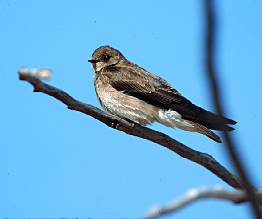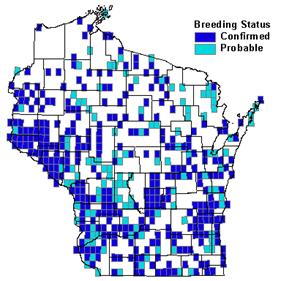Photo by Jack Bartholmai


Status/Protection
- Global Rank: G5 Key to global and state ranks
- State Rank: S4B
- WBCI Priority: PIF
Population Information
The Federal BBS information can be obtained at http://www.mbr-pwrc.usgs.gov/bbs/bbs.html by clicking on Trend Estimates and selecting the species in question. All estimates are for time period (1966-2005).
- Federal Breeding Bird Survey: non-significant increase
- Federal Breeding Bird Survey (WI): non-significant decline
- Federal Breeding Bird Survey (BCR 23): non-significant decline
- Federal Breeding Bird Survey (BCR 12): non-significant decline
- Nicolet National Forest Bird Survey (UWGB): significant decline (Howe and Roberts 2005)
- WSO Checklist Project: stable (1983-2007)
Life History
- Breeding Range: Southern Canada throughout the contiguous U.S. south into Mexico and Central America (DeJong 1996).
- Breeding Habitat: Inland Open Water, shorelines of watercourses.
- Nest: Burrow in earthen bank, commonly 30-100 cm deep (DeJong 1996).
- Nesting Dates: Eggs: mid-May to late June (Robbins 1991).
- Foraging: Aerial forage (Ehrlich et al. 1988).
- Migrant Status: Short-distance/Neotropical migrant.
- Habitat use during Migration: Diverse habitats - open country, open forest, water, and urban areas (Turner and Rose 1989).
- Arrival Dates: Mid-April to mid-May (Robbins 1991).
- Departure Dates: Early July to mid-September (Robbins 1991).
- Winter Range: Extreme southern U.S. and Central America (DeJong 1996).
- Winter Habitat: Lowlands, foothills and river channels - roosts in Costa Rican sugar cane fields (DeJong 1996).
Habitat Selection
The Northern Rough-winged Swallows often occur in open habitats, predominately near rocky gorges and exposed banks (DeJong 1996). In Wisconsin, it frequently occurs near small streams with steep exposed banks (Robbins 1991), where it nests in artificial substrates including gutters, culverts, drainpipes, and holes in structures and in burrows along vertical banks. Burrows are located in clay, sand, or gravel banks and range from 20-200 cm deep. The Northern Rough-winged Swallow typically uses burrows excavated by kingfishers, Bank Swallows, and other species. It will nest singly or in loose colonies of 2-25 pairs (DeJong 1996).
Habitat Availability
Although the Northern Rough-winged Swallow has been recorded in every Wisconsin county, it is less common north of a line from Grantsburg to Oconto (Robbins 1991). The highest concentrations occur in west-central Wisconsin, likely due to an abundance of nesting sites afforded by the bluff geography (Damro 2006). Human activities that impede natural erosion of streamside banks may impact breeding habitat suitability. This species will readily use artificial structures for nesting in the absence of natural sites. However, burrow availability, both artificial and natural, appears to be a limiting factor for this species (DeJong 1996).
Population Concerns
Breeding Bird Survey data suggest a non-significant increase range-wide and a non-significant decline in Wisconsin (Sauer et al. 2005). However, accurate population estimates are difficult because of this species’ localized distribution and limited availability of nest sites (DeJong 1996). In Wisconsin it is considered a fairly common summer resident south and central and an uncommon summer resident north (Robbins 1991). During the Wisconsin Breeding Bird Atlas (1995-2000), observers confirmed breeding in approximately 29% of the surveyed quads (Damro 2006).
The direct loss of natural sites through flood control and bank stabilization projects may impact local populations. The lack of suitable nesting burrows also may be limiting populations (DeJong 1996). Little is known about threats on the wintering grounds.
Recommended Management
The Northern Rough-winged Swallow is a poorly known species, thus management recommendations are difficult to formulate. Because this species may be limited by the availability of nesting burrows, the placement of artificial nest burrows in appropriate habitat may be one management strategy. All natural sites with current or potential colonies should be identified and conserved in Wisconsin. Wherever possible, managers should consider maintaining natural cycles (i.e., flooding and erosion) in riparian ecosystems, which will benefit many riparian-associated species. However, public education on the importance of these natural processes is needed. Loose colonies located at quarries and other human-altered habitats would benefit from fewer disturbances at nesting sites.
Research Needs
The Northern Rough-winged Swallow is not well-studied. More research on both its breeding and wintering ecology is needed. Studies investigating variations amongst eastern and western populations (e.g., molt, migration, breeding chronology, colony size) are warranted. More information is needed on this species’ ability and propensity to excavate burrows (DeJong 1996). In Wisconsin, important breeding sites should be identified.
Information Sources
- Chequamegon National Forest Bird Survey (NRRI) species account: http://www.nrri.umn.edu/mnbirds/accounts/NRWSa2.htm
- Nicolet National Forest Bird survey map: http://www.uwgb.edu/birds/nnf/species/NRWS.htm
- North American Breeding Bird Survey: http://www.mbr-pwrc.usgs.gov/bbs/bbs.html
- Temple S.A., J.R. Cary, and R. Rolley. 1997. Wisconsin Birds: A Seasonal and Geographical Guide. Wisconsin Society of Ornithology and Wisconsin Department of Natural Resources, Madison, WI.
- Wisconsin Breeding Bird Atlas: http://www.uwgb.edu/birds/wbba/
References
- Damro, K. 2006. Northern Rough-winged Swallow. In Atlas of the Breeding Birds of Wisconsin. (N.J. Cutright, B.R. Harriman, and R.W. Howe, eds.) The Wisconsin Society for Ornithology, Inc. 602pp.
- DeJong, M.J. 1996. Northern Rough-winged Swallow (Stelgidopteryx serripennis). In The Birds of North America, No.234 (A. Poole and F. Gill, eds.). The Academy of Natural Sciences, Philadelphia, and the American Ornithologists’ Union Washington, D.C.
- Ehrlich, P.R., D.S. Dobkin, and D. Wheye. 1988. The birders handbook: a field guide to the natural history of North American birds. Simon & Schuster, Inc. New York.
- Howe, R.W. and L.J. Roberts. 2005. Sixteen years of habitat-based bird monitoring in the Nicolet National Forest. In C.J. Ralph and T.D. Rich, editors. Bird Conservation Implementation and Integration in the Americas: Proceedings of the Third International Partners in Flight Conference. 2002 March 20-24; Asilomar, California, Volume 2. Gen. Tech. Rep. PSW-GTR-191. Albany, CA: Pacific Southwest Research Station, Forest Service, U.S. Department of Agriculture. 643 p.
- Robbins, S.D. 1991. Wisconsin birdlife: population & distribution, past & present. Univ. of Wisconsin Press, Madison, WI.
- Sauer, J.R., J.E. Hines, and J. Fallon. 2005. The North American Breeding Bird Survey, Results and Analysis 1966 - 2005. Version 6.2.2006. USGS Patuxent Wildlife Research Center, Laurel, MD.
- Turner, A. and A.C. Rose. 1989. Swallows and Martins: An Identification Guide and Handbook. Houghton Mifflin Company, Boston.
Contact Information
- Compiler: Ken Damro, kendamro@yahoo.com
- Editor: Kim Kreitinger, K.Kreitinger@gmail.com
